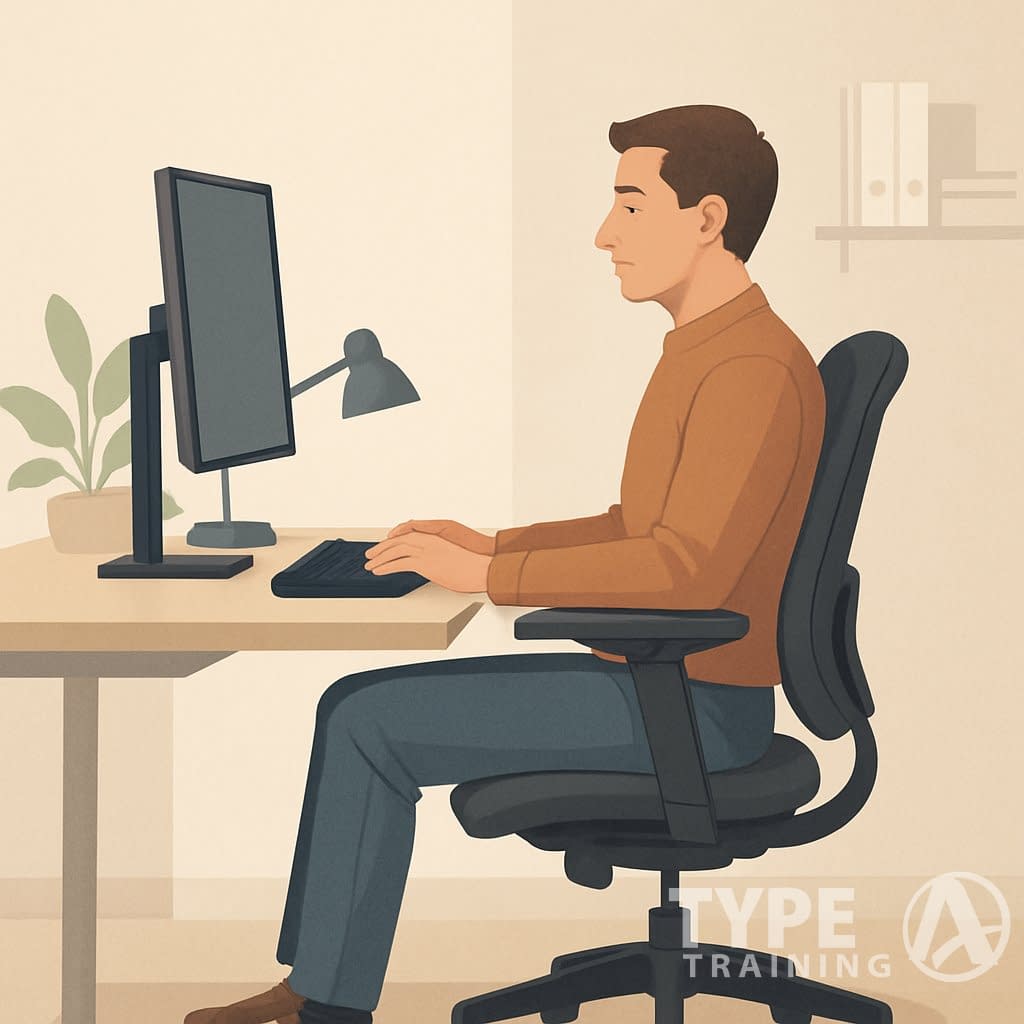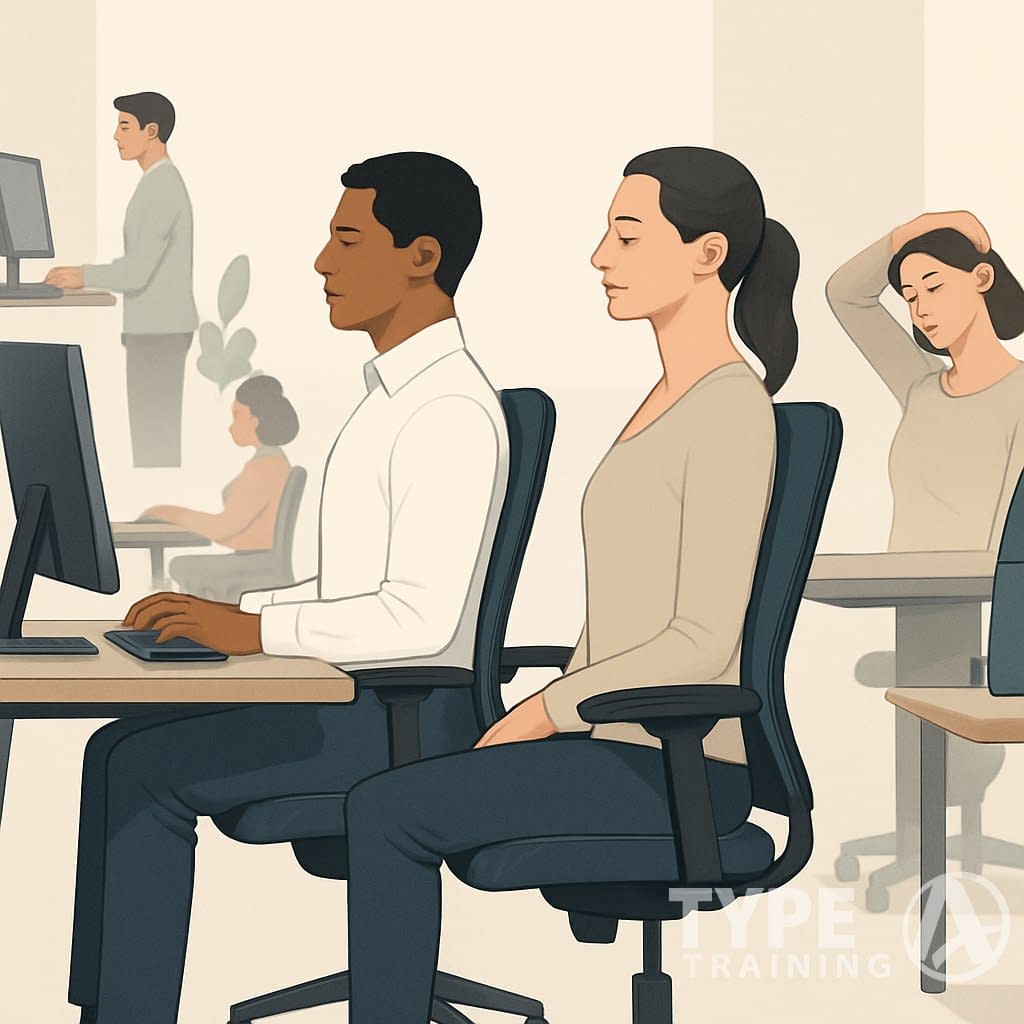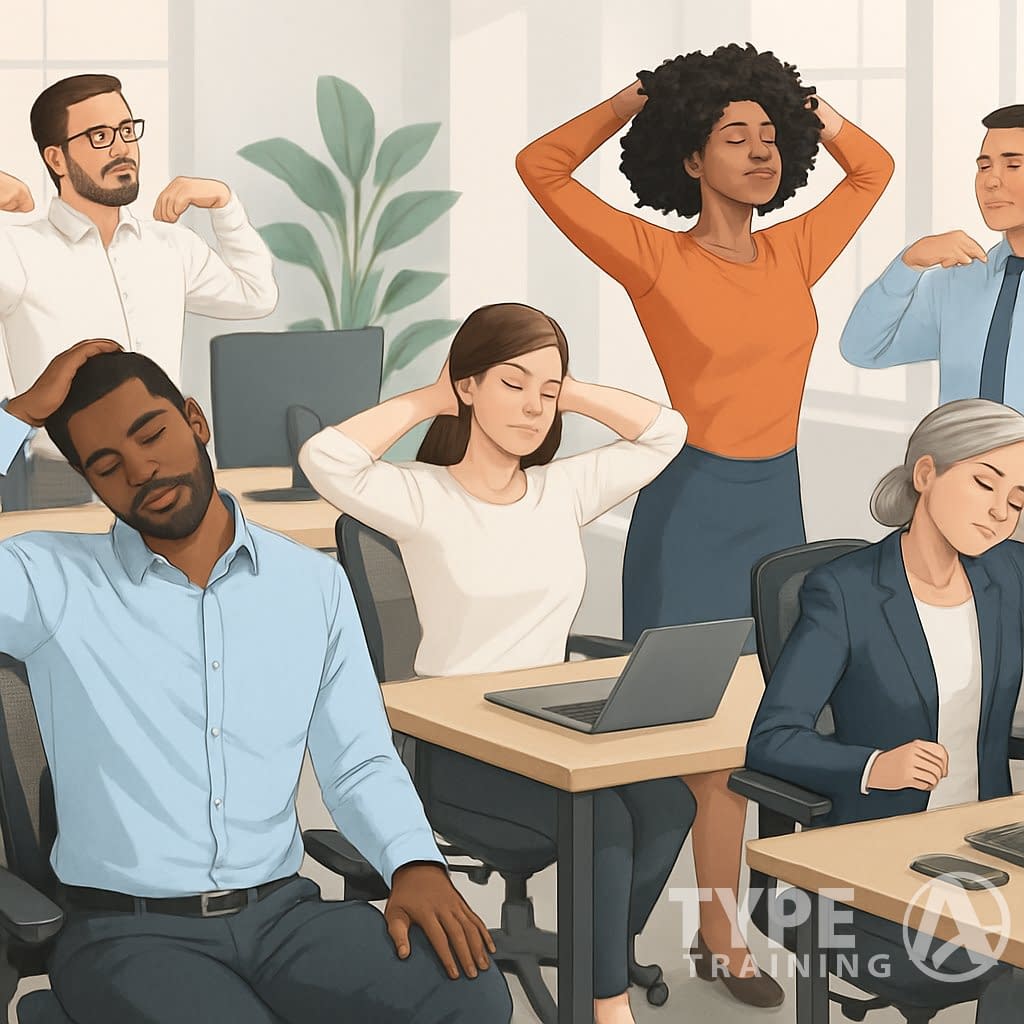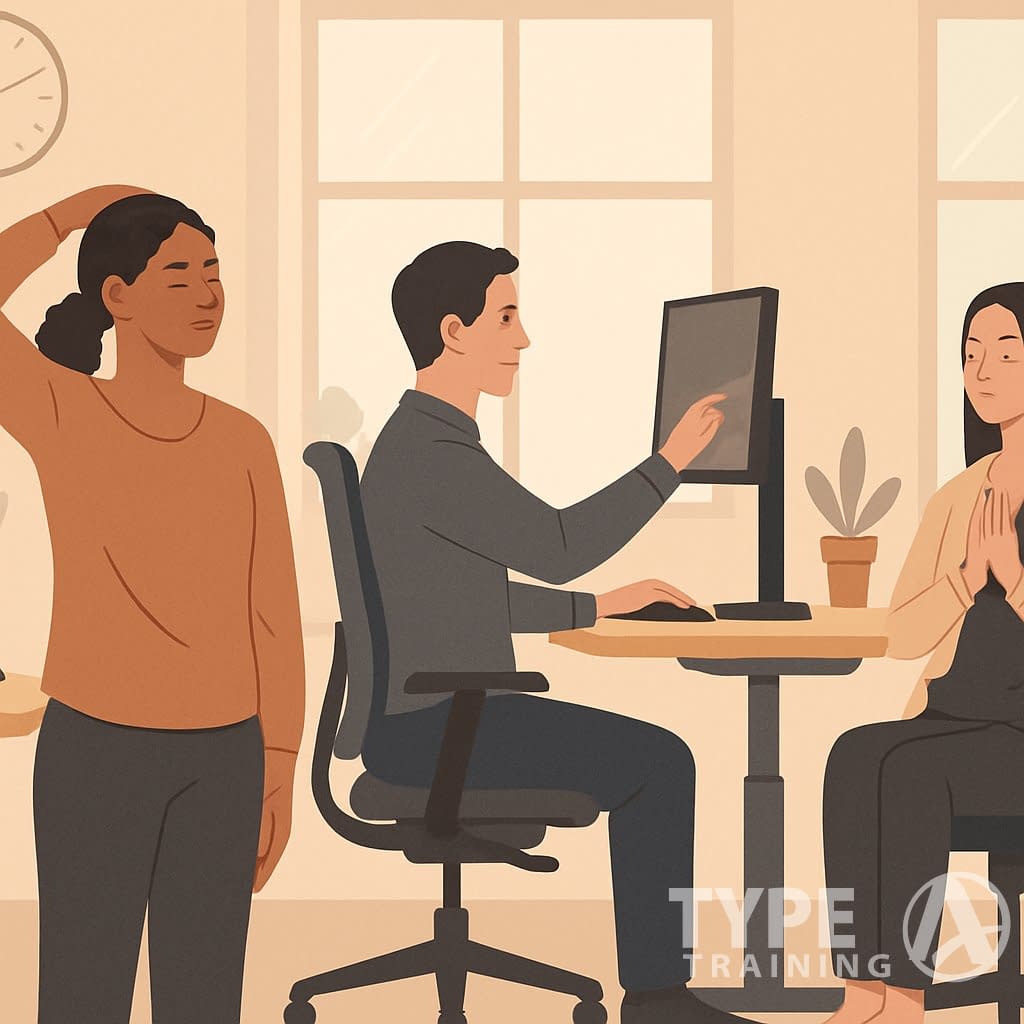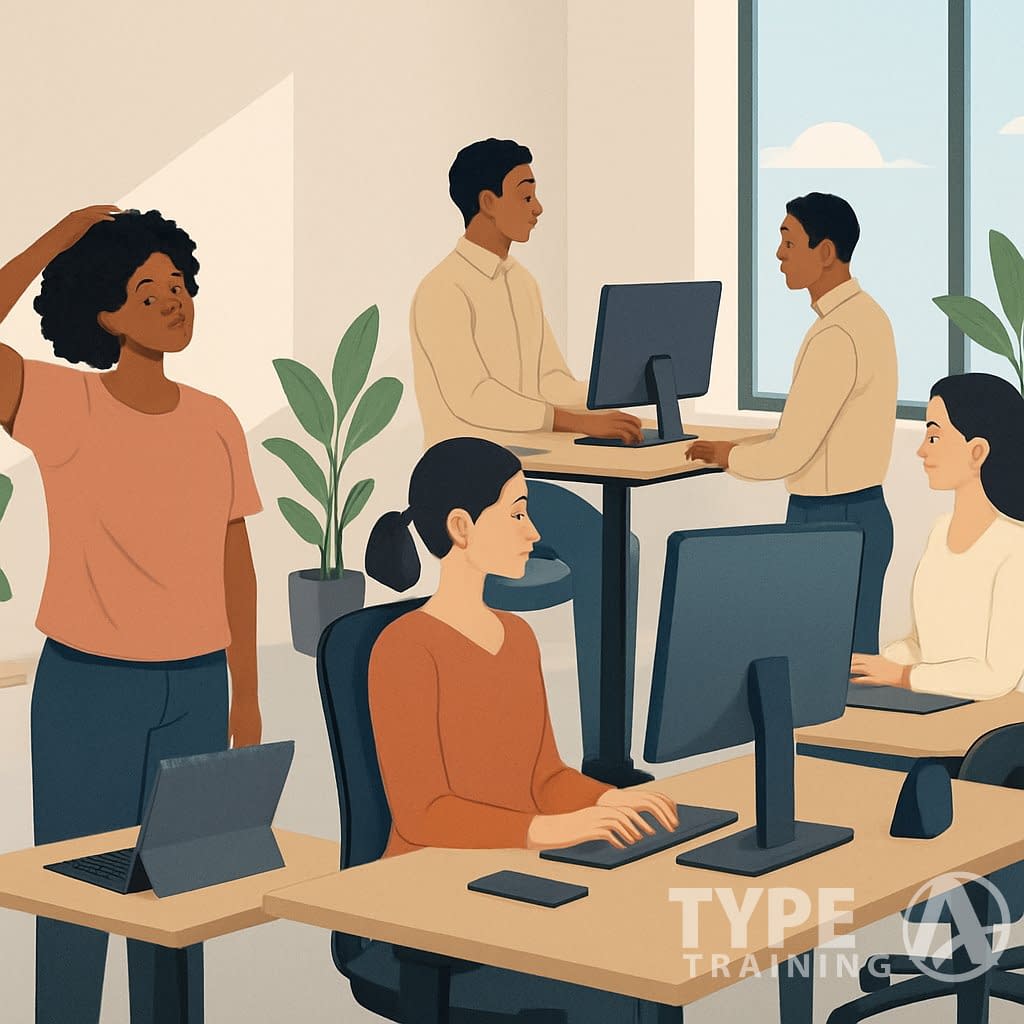You spend hours every day staring down at screens, tablets, and phones. That constant downward gaze puts a ton of strain on your neck and upper back muscles.
This forward head posture makes your cervical spine work way harder than it should. Over time, it leads to pain, stiffness, and less mobility—stuff that can really mess with your work and daily life.

You can absolutely prevent tech neck if you set up your workstation right, take posture breaks, and do targeted exercises to strengthen your neck and shoulders. This condition affects millions of people at their desks, causing headaches, muscle tension, and sometimes even nerve pain that shoots down your arms.
Popular posts:
To prevent tech neck in the digital workplace, ensure you keep your workstation ergonomic and take regular breaks to stretch and adjust your posture.
Simple tweaks to your routine can help you ditch tech neck pain for good. If you know what causes it and use some proven strategies, you can keep your neck and spine happy while staying productive.
By integrating exercises to prevent tech neck in the digital workplace, you can significantly improve your comfort at your desk.
Key Takeaways
- Tech neck comes from too much screen time and lousy posture, leading to pain and stiffness
- Good workstation ergonomics and regular movement breaks are crucial
- Strengthening exercises and stress management help protect against tech neck
Understanding Tech Neck and Its Impacts
Understanding how to prevent tech neck in the digital workplace involves knowing the causes and symptoms of this condition.
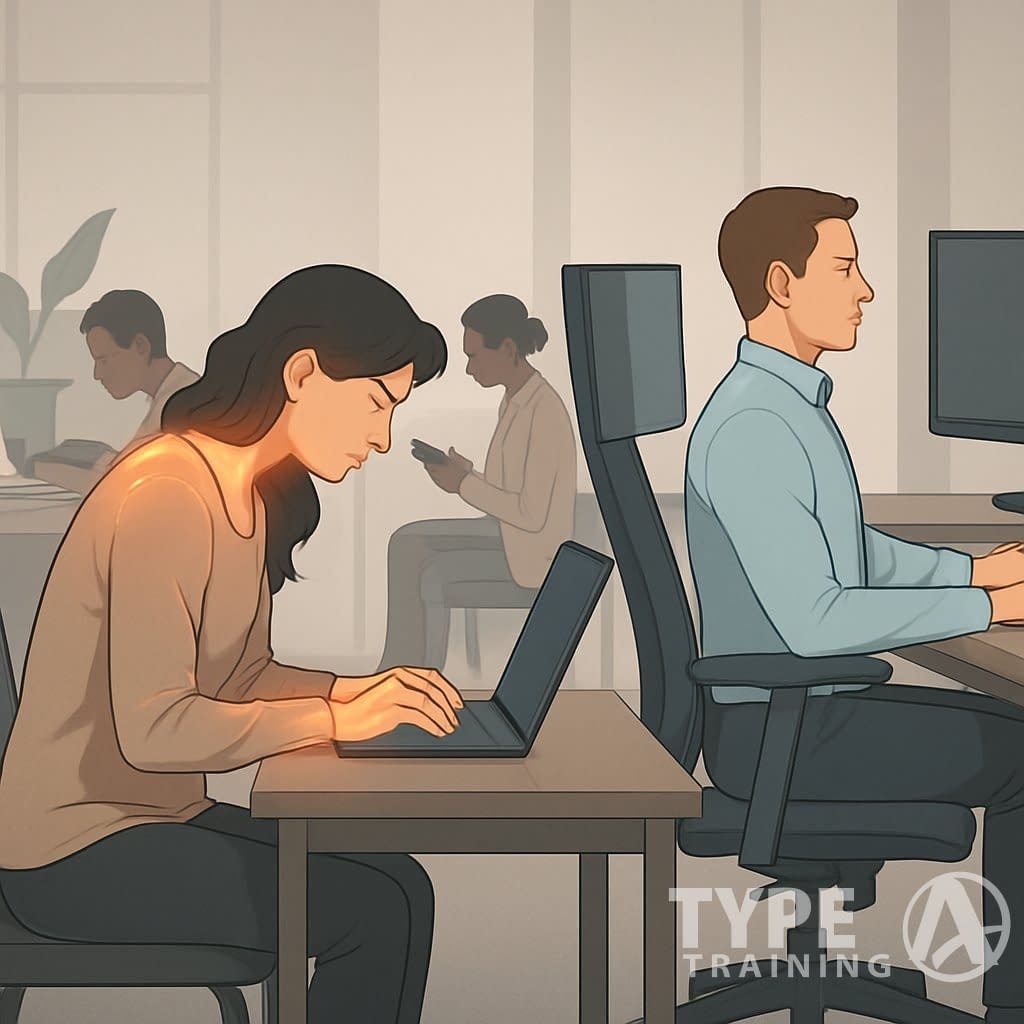
Tech neck hits millions of workers glued to digital devices, causing neck strain and cervical spine problems. The health risks aren’t minor—they can dent your well-being and productivity.
Taking proactive steps to prevent tech neck in the digital workplace can safeguard your health and productivity.
What Is Tech Neck?
Tech neck is basically strain and injury in your neck muscles and cervical spine from always looking down. It happens when you spend hours hunched over your phone, tablet, or laptop.
Your head weighs about 10 to 12 pounds when it’s upright. Tilt it forward just 15 degrees and your neck suddenly supports 27 pounds. At 60 degrees, that load jumps to a whopping 60 pounds.
That kind of stress wears down your cervical spine fast. Your neck muscles have to work overtime to keep your head up during long screen sessions.
After a while, this repeated stress throws your muscles out of balance and messes with your joints. The constant forward head position weakens your upper back muscles while tightening your chest and the front of your neck.
Common Symptoms and Risks
Tech neck brings both immediate symptoms and longer-term problems that can mess with your work and home life.
Immediate symptoms:
Recognizing the immediate symptoms can help you address tech neck and learn to prevent tech neck in the digital workplace effectively.
- Neck pain and stiffness
- Upper back and shoulder pain
- Tension headaches
- Reduced neck mobility
- Jaw pain
You might also notice tingling or numbness in your arms and hands. Some folks even have trouble breathing well, since poor posture can limit lung capacity.
Long-term risks:
-
- Cervical disc herniation
Long-term risks can be minimized if you learn how to prevent tech neck in the digital workplace.
- Pinched nerves and chronic pain
- Degenerative disc disease
- Loss of the natural curve in your neck
- Trouble with balance and coordination
These issues can get expensive to treat and might mean missing work. Not exactly ideal.
Causes of Tech Neck in Modern Offices
To truly prevent tech neck in the digital workplace, you must recognize the signs and implement ergonomic practices.
A few things at work make tech neck way more likely.
Screen time is the big one. Most office workers stare at screens for 7+ hours a day, keeping their head forward most of the time.
Workstation setup can make things worse. Monitors that are too low force you to look down, and laptops on desks create awkward angles that strain your neck.
Lack of movement is another culprit. If you sit for hours without moving, your core and postural muscles get weak and bad habits set in.
Mobile devices just pile on more strain. Checking your phone or tablet all day adds to your total screen time and neck stress.
Optimizing Workstation Ergonomics
The way you set up your workstation matters a lot for your spine health and tech neck risk. Screen height, supportive seating, and a posture-friendly workspace all play a role.
A well-set workstation can effectively prevent tech neck in the digital workplace and improve your overall comfort.
Setting Up an Ergonomic Workspace
Keep your body in a neutral position. Place your keyboard and mouse so your arms rest at a 90-degree angle.
Don’t reach or twist for things you use often—keep them close. That way, you avoid unnecessary neck and spine stress.
Feet should be flat on the floor, knees at hip level. If your desk is too high, try a footrest.
Workspace basics:
| Component | Proper Position |
|---|---|
| Elbows | 90-degree angle |
| Knees | At hip level |
| Feet | Flat on floor |
| Wrists | Straight and neutral |
Let the light come from the side, not behind your screen. That cuts down on glare and keeps you from leaning forward.
If you work with documents, use a holder at the same height as your screen. It saves your neck from all that up-and-down movement.
Monitor and Screen Placement Best Practices
Monitor placement is crucial to prevent tech neck in the digital workplace and maintain good posture.
Set your monitor about arm’s length away—roughly 20 to 26 inches. The top should be at or just below eye level.
If your screen sits too low, you’ll end up tilting your head down all day. That’s a recipe for tech neck.
Try a monitor stand or laptop riser to get the right height. Stack up some books if you don’t have fancy equipment.
With dual monitors, keep your main screen right in front of you and angle the secondary one toward you at the same height.
If you use multiple devices: Plug in an external keyboard and mouse for your laptop. That way, you can raise the screen without messing up your arm position.
Tilt your monitor back 10 to 20 degrees. That little angle helps keep your head neutral and eases neck strain.
Importance of Supportive Seating
A good ergonomic chair supports the curve in your lower back. Bad back support leads to slouching and forces your neck and shoulders to work too hard.
Look for a chair with adjustable height, armrests, and back tilt. You want it to fit your body and your work style.
The chair’s back should follow your spine’s natural S-curve. Adjustable lumbar support is a big plus.
Standing desks are an option if you’re tired of sitting. Try switching between sitting and standing every 30 to 60 minutes to avoid muscle stiffness.
Quick chair checklist:
- Seat height lets your feet rest flat
- Back rest supports your lower back
- Armrests help without lifting your shoulders
- Seat depth leaves a couple of inches behind your knees
Sit with your back against the chair and don’t slouch. Your ears should be over your shoulders for the best neck alignment.
If your chair’s worn out and saggy, replace it. Old chairs encourage bad posture and make tech neck worse.
Posture and Movement Strategies
Good posture is essential to prevent tech neck in the digital workplace, along with regular movement breaks.
Good posture and regular movement breaks are your best tools for avoiding tech neck. Cutting down on screen time helps too, since it eases muscle tension and keeps things balanced.
By integrating movement into your routine, you can effectively prevent tech neck in the digital workplace.
Maintaining Proper Posture at Your Desk
Set your screen at eye level so your head stays neutral. That stops you from tilting or craning your neck.
Keep your monitor 20-24 inches away. Shoulders should stay relaxed and back. Feet flat, knees at a right angle.
Posture checkpoints:
- Head above shoulders
- Shoulders back and down
- Back straight against chair
- Elbows at about 90 degrees
You need lumbar support to keep your spine’s curve. If you use a laptop, prop it up and use an external keyboard so you’re not always looking down.
Check your posture every half hour. It’s easy to slip into bad habits, and that’s when muscles start to tighten or weaken.
Integrating Movement and Microbreaks
Get up every 30-60 minutes. Even a quick 2-3 minute walk helps break up tension.
Try some neck stretches during breaks. Drop your right ear to your right shoulder for 20 seconds, then switch sides.
Desk exercises to try:
- Squeeze shoulder blades together (10 reps)
- Neck side bends (20 seconds per side)
- Gentle neck rotations (5 per direction)
- Stretch your chest in a doorway (30 seconds)
Roll your shoulders back 10 times every hour. It’s a simple reset for your posture. Set a phone reminder if you tend to forget.
Even little movements count. Shift your weight or do shoulder rolls without leaving your chair.
Limiting Screen Time and Device Dependency
To manage your screen time, learn how to prevent tech neck in the digital workplace through structured breaks.
Check how much screen time you rack up with your phone’s built-in tools. Most people spend way more time staring at devices than they realize.
Set specific times to check your phone instead of picking it up constantly. Turn off notifications you don’t need—they’re just tempting you to look down.
How to cut screen time:
-
- Use the 20-20-20 rule: every 20 minutes, look at something 20 feet away for 20 seconds
Using reminders can help you remember to prevent tech neck in the digital workplace by taking breaks.
- Text with your phone at eye level
- Take phone-free breaks at lunch
- Try voice-to-text instead of typing everything
App limits can help, too. Swap some screen time for activities that let your neck relax. Your muscles will thank you.
Preventive Exercises for Neck and Back Health
Prevent tech neck in the digital workplace by incorporating exercises that promote neck and back health.
Regular exercises can ease neck strain and build up the muscles that keep your posture in check. Stretching and strengthening the right areas makes a real difference if you’re stuck at a desk all day.
Essential Stretching Exercises
Essential stretching exercises can help prevent tech neck in the digital workplace and alleviate tension.
Start with chin tucks—pull your head back and tuck your chin down a bit. Hold for 5 seconds, repeat 10 times.
Neck rolls loosen up tension in all directions. Slowly roll your head in a circle, pausing at each quarter turn. Do 5 rotations going each way.
Shoulder rolls help with upper back stiffness. Move your shoulders up, back, and down in circles—10 forward, then 10 backward.
For side neck stretches, tilt your head toward one shoulder and hold for 20 seconds. Use your hand for a little extra stretch if you want.
Try to stretch every 2-3 hours while you work. Set a reminder so you don’t forget.
Strengthening the Neck and Shoulders
Shoulder blade squeezes are great for weak postural muscles. Sit tall, squeeze your shoulder blades together for 5 seconds, then relax. Do 15 reps.
Shoulder shrugs work your upper traps. Lift your shoulders to your ears, hold for 3 seconds, then drop them. Try 3 sets of 10.
Wall push-ups strengthen your chest and shoulders. Stand arm’s length from the wall and do push-ups against it to fight forward head posture.
Aim for these strength exercises 3-4 times a week. Start easy and ramp up as you get stronger.
Resistance bands are handy, too. Use them for rows or external rotations to hit those often-neglected back muscles.
Incorporating Mind-Body Practices
Practicing exercises like yoga can help you prevent tech neck in the digital workplace and maintain flexibility.
Yoga blends stretching and strength training for better neck health. Cat-cow poses get your whole spine moving and build up the core muscles that support your posture.
Pilates zeroes in on core stability and alignment. The neck pull exercise targets forward head posture and works the deep neck flexors.
Swimming offers full-body conditioning without putting strain on your neck. Backstroke and sidestroke can be especially good choices for folks dealing with tech neck.
Aerobic exercise boosts circulation and eases muscle tension. Even a brisk walk, some cycling, or a spin on the elliptical for 30 minutes a day can help your neck.
Mind-body practices build body awareness. You start to notice tension before it turns into pain.
This awareness makes it easier to tweak your posture during the workday.
Incorporating different approaches can help you prevent tech neck in the digital workplace effectively.
Try mixing different approaches. For example, do 10 minutes of stretching, 5 minutes of strengthening, and 20 minutes of yoga or swimming.
Lifestyle and Stress Management for Long-Term Prevention
Developing strategies to prevent tech neck in the digital workplace is essential for long-term health.
Stress tightens muscles and makes tech neck symptoms worse. Bad workplace habits just pile on more strain.
Managing your stress and tweaking your daily routine can help you avoid chronic pain and future spine problems.
Managing Stress and Avoiding Tension
Chronic stress makes your neck and shoulders tense up. That tension just feeds into more tech neck pain.
Managing stress can help prevent tech neck in the digital workplace by reducing muscle tension.
Daily stress management techniques:
Incorporating stress management techniques can assist in preventing tech neck in the digital workplace.
- Try deep breathing every few hours
- Take quick 5-minute meditation breaks between tasks
- Use progressive muscle relaxation at lunch
Meditation helps ease muscle tension. Just 3-5 minutes a day with simple breathing can make a difference.
Focus on relaxing your neck and shoulders while you meditate.
When you get stressed, your body tends to hunch forward. That puts even more strain on your neck.
Regular stress breaks help you avoid slipping into this posture.
Headaches can be an early warning sign—stress and bad posture often team up to cause them. Catch it early before it turns into something chronic.
Keep a stress ball or fidget tool at your desk. Sometimes you just need to squeeze something to let off steam.
Building Healthy Workplace Habits
Building healthy habits at work can prevent tech neck in the digital workplace and improve your comfort.
Your daily habits really do make or break your neck health. Even small changes can protect you from muscle strain and injury.
Essential workplace habits:
- Set reminders every hour to check your posture
- Stand and stretch for two minutes every half hour
- Keep water nearby so you have a reason to move
- Arrange your desk so you don’t have to reach awkwardly
Start your morning with some neck stretches. It’s a simple way to wake up your muscles and avoid stiffness.
Try standing or walking while you take phone calls. It breaks up the sitting and naturally resets your posture.
Put breaks in your calendar like you would any meeting. Treat them as must-dos, not optional.
Adjust your lighting so you’re not squinting or leaning forward. Poor lighting makes you crane your neck without even realizing it.
For the complete posture training system, check out The Ultimate Guide to Posture Training for Busy Professionals.
Frequently Asked Questions
Understanding how to prevent tech neck in the digital workplace can help alleviate concerns among workers.
Lots of workers wonder how to actually prevent and treat tech neck. Knowing the right exercises, symptoms, and fixes makes it easier to keep neck pain at bay.
What are effective neck exercises to prevent strain in office workers?
Chin tucks are a go-to for office workers. Just pull your chin back gently, like you’re making a double chin, hold for five seconds, and do this ten times through your day.
Shoulder blade squeezes help undo that forward head posture. Squeeze your shoulder blades together, hold, and release.
Neck rolls loosen up tight muscles from all that computer time. Roll your head in a slow circle, but skip rolling backward to avoid strain.
Regular exercises can help prevent tech neck in the digital workplace by addressing tight muscles and improving posture.
Side neck stretches target those tight side muscles. Tilt your head gently to one side, hold for 15-30 seconds, and switch sides.
Do these every 30-60 minutes if you can. Start with five to ten reps and bump it up as your muscles get stronger.
What are the common symptoms of tech neck and how can they be mitigated?
Identifying common symptoms of tech neck can aid in learning how to prevent tech neck in the digital workplace.
Stiffness and soreness in your neck are usually the first signs. You might feel worse after a long stretch at your computer.
Headaches can hit, too—usually from tense neck and shoulder muscles. They often start at the base of your skull.
Sometimes you can’t turn your head as far as usual. Your neck might feel locked up or just tight.
Upper back fatigue can give you that burning feeling between your shoulder blades. It’s your muscles working overtime to hold up bad posture.
Take breaks every half hour or so to stretch and reset. Keep your screen at eye level to avoid bending your neck.
Taking regular breaks is essential to prevent tech neck in the digital workplace and reset your posture.
Use ice for sudden pain or heat for ongoing tension. Ice calms inflammation, while heat loosens things up.
Is it possible to reverse the effects of tech neck, and if so, how?
You can definitely turn tech neck around with steady effort. Most people start to feel better in two to four weeks if they stick with it.
Work on your posture first. Try to keep your ears lined up over your shoulders.
Regular stretching and strengthening help balance your muscles. Tight ones need stretching; weak ones need some work.
Make your workspace ergonomic. Adjust your monitor, chair, and keyboard so everything lines up.
If things are really bad, don’t be afraid to see a pro. Physical therapists and chiropractors know their stuff.
Consistent efforts can help prevent tech neck in the digital workplace and promote overall well-being.
Honestly, consistency matters more than anything. Small changes every day beat the occasional big fix.
What are the best ergonomic practices to avoid developing tech neck?
Set your computer screen at eye level so your neck stays neutral. The top of the monitor should be at or just below your eyes.
Pick a chair with good lumbar support. Plant your feet flat and keep your knees at a comfy 90 degrees.
Keep your keyboard and mouse at elbow height. Your arms should hang naturally, not reaching up or down.
Hold your phone up to eye level instead of looking down. A phone stand is handy for long calls or reading.
Adopting ergonomic practices can significantly prevent tech neck in the digital workplace and enhance comfort.
Move around every half hour or so. Stand, stretch, or walk to reset your posture.
A document holder next to your screen can help. It saves your neck from constant turning.
How can one manage and treat pain specifically associated with tech neck?
Start with ice for the first couple of days if you’re hurting. Fifteen to twenty minutes with an ice pack helps with swelling.
Switch to heat after the initial soreness fades. Heat relaxes tight muscles and gets blood flowing.
Over-the-counter pain meds can help for a bit. Always follow the directions and talk to a doctor if the pain sticks around.
Taking care of neck pain is vital to prevent tech neck in the digital workplace and ensure daily productivity.
Gentle massage can loosen up your neck, shoulders, and upper back. Sometimes it’s just what you need.
Physical therapy or chiropractic care are good options if you need more targeted help.
Try to avoid things that make your pain worse while you recover. That might mean less screen time or a temporary desk tweak.
What role do supportive accessories, like pillows, play in preventing tech neck?
Ergonomic pillows help your neck stay aligned while you sleep. If you pick one that keeps your head lined up with your spine, you’ll probably feel the difference.
Lumbar support cushions keep your lower back’s natural curve in place. They make sitting for long stretches a bit less punishing.
Using supportive accessories can help prevent tech neck in the digital workplace by promoting better posture.
Document holders can save your neck from all that twisting between papers and screens. Honestly, just set them up at the same height as your monitor and you’re good.
Monitor stands lift your screen to eye level. You don’t need fancy gear—sometimes a stack of old books does the trick.
Phone stands are underrated. They stop you from bending your neck every time you watch a video or take a call.
Wrist rests help keep your hands in a comfortable spot and might ease some shoulder tension. Just make sure your wrists stay straight when you’re typing.

